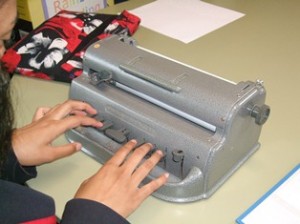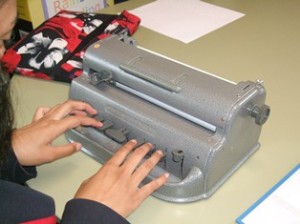Alisha is a sixteen year old student currently in year 12. Alisha’s primary sensory channel for learning is vision which she supports with her auditory skills.
Alisha has a significant eye condition which is impacting greatly on her ability to access the curriculum despite the accommodations and adaptations made within the school.
The main goal is for Alisha to adopt a dual sensory approach to her learning using visual/auditory or visual/tactile skills. This will allow her to utilize the appropriate skills to meet her needs for a particular task in the long term. She has begun learning grade one (uncontracted) braille this year due to a significant change in her visual functioning.
In figure 1 Alisha is practising brailling the alphabet from A-Z. Alisha receives specialist instruction in Braille from her Resource Teacher Vision Simone Powell.
What is happening now?
Alisha is learning to write 5 new word-signs outlined in the FUNdamentals Program. She is being taught a rule relationship that the letters b, c, d, f and g also represent whole words known as whole word-signs (b-but, c-can, d-do, e-every and f-from)
Figure 2 shows Alisha writing the word sign ‘can’.
Prerequisite skills
Current skills to mastery level:
- Can braille alphabet from A-Z.
- Can braille her full name.
- Can braille and read letters A/T/M and three lettered words comprised of those letters.
- Can correctly write a capital letter sign, full stop, comma, question mark and exclamations mark.
In figure 3 Alisha is writing the word-sign ‘do’.
Possible next steps
- To learn all whole word signs.
- To tactually discriminate between capital letter sign, full stop, comma, question mark and exclamation mark.
- To learn short form words, lower cells and common combinations.
- To complete full sentences in grade one braille.
- To read whole words in isolation.
Teaching methods and strategies
The main teaching strategy was the Direct Instruction model. This applies a very structured approach to learning by using set scripts for each new learning opportunity. The structure of each lesson is comprised of four parts.
- Frame – scripted instruction of new-learning followed by a request from teacher to learner to confirm what is going to be taught.
- Model – teacher to say and do the task.
- Lead – choral responding with student and teacher doing the task in unison.
- Test – Student to perform the task on their own.
Learning adaptations
Enlarged pictures of braille cells a-z provided Alisha with visual cues as to what each cell looked like. The learning environment is a room with good natural lighting. Flashcards are use to support reading and tactual discrimination.
Assessment
The Pre-Braille Assessment was chosen because it was crucial to establish a benchmark of what the student could do. The learner must reach a certain level of cognitive and physical function before embarking on an instructional program to learn braille.
The Braille Assessment (page one) is a comprehensive checklist that breaks down the first 5 initial stages of the braille learning process. All five stages increase in the degree of difficulty, starting with individual cells (letters) to more complicated cell combinations that consisting of contracted word and multiple cells. This assessment produces a running record of what the students can and can’t do. This information informs the teaching in the instructional process.
Useful Links
- A (Slightly) Different Introduction to Braille – Dotless Braille website.
- Strategies and Resources for Teaching Braille to Adults – American Foundation for the Blind website.
- Instructional Strategies for Teaching Braille – Paths to Literacy website.
- Braille FUNdamentals – A Braille Curriculum for VI Students from Primary to High School Levels – TSBVI website.
- Braille Flashcard applications for Mac and PC – Braille through Remote Learning website.
More information
Email us at BLENNZ Online for more information about this subject.
We will link you up with either the author of this post or another BLENNZ colleague with whom you can continue your conversation.



